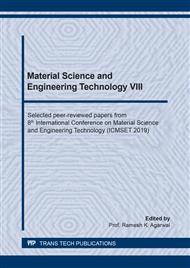p.227
p.233
p.239
p.246
p.255
p.261
p.266
p.271
p.277
Synthesis and Characterization of Polycaprolactone(PCL)/Organo-Montmorillonite(O-MMT) Blendvia Solvent Casting
Abstract:
Polycaprolactone (PCL) is a hydrophobic, semi-crystalline polymer that has been broadly applied in long term implants, drug release applications, and in the tissue engineering field due to its availability, relatively inexpensive price and suitability for modification. Organo-montmorillonite (O-MMT) clay has been extensively used for various polymer-nanocomposite studies and widely used as adsorbent due to its high specific surface area. Most polymer clay nanocomposites are involved in biomedical applications such as in drug delivery systems and wound healing. In this study, O-MMT was incorporated to PCL via solvent casting, which resulted into film membranes that were characterized to identify its surface morphology, chemical structure, wettability, mechanical property, pore size, and antibacterial properties upon its varying concentrations. The SEM and FTIR results indicated the presence of both PCL and O-MMT within the membrane. The mechanical properties of the film membranes showed an improvement upon reaching an optimal point. An increase in pore size was determined relative to its hydrophilicity. The film membrane showed an antibacterial activity only at the higher concentrations of the O-MMT using the S. aureus strain. As such, the results showed that there is an improvement in the mechanical, wettability, water absorption and antibacterial properties of the PCL with the incorporation of the O-MMT, making it a viable candidate dressing material for wound healing.
Info:
Periodical:
Pages:
255-260
Citation:
Online since:
June 2020
Price:
Сopyright:
© 2020 Trans Tech Publications Ltd. All Rights Reserved
Share:
Citation:


